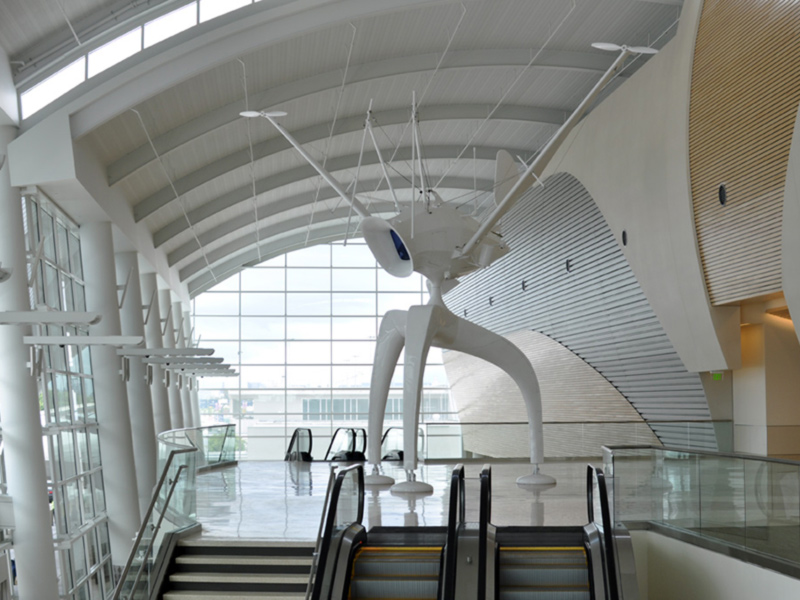A noise abatement procedure is a recommended flight path aircraft follow to minimize noise over a populated area. Because this is a recommended procedure, pilots may decline to follow it due to safety concerns or other operating considerations. For some noise abatement procedures, a pilot must be able to see specific visual cues. If the visual cues are not visible, the pilot will not be able to safely follow the noise abatement procedure. Other procedures rely on navigational equipment capabilities.
To more consistently and easily describe and compare noise environment comprised of numerous single events that vary in duration and magnitude over long periods of time, the U.S. Environmental Protection Agency developed a single number descriptor. This descriptor is the CNEL/DNL. It is a noise metric which describes and average day/night sound level. The CNEL/DNL metric is used by the FAA to quantify aircraft noise exposure in the vicinity of an airport. Noise contours of specific DNL levels are developed using the FAA’s Integrated Noise Model (INM). Airport specific data used in the INM model to develop the contour will result in the depiction on noise exposure in the vicinity of an airport. Airport specific data used in the INM include: Average Daily Operations, Aircraft Fleet Mix, Runway Use, Flight Corridors and Usage, Departure Destinations and Day/Night Use.
CNEL/DNL (Day-Night Sound Level) is based on sound levels measured in relative intensity of sound, or decibels (dB), on the “A” weighted scale (dBA). This scale most closely approximated the response characteristics of the human ear sound. The higher the number on the scale, the louder is the sound. CNEL represents noise exposure events over a 24-hour period. To account for human sensitivity to noise between the hours of 10 p.m. and 7 a.m., noise events occurring during these hours receive a “penalty” when the CNEL is calculated. Each nighttime event is measured as if ten daytime events occurred.
The Noise Office uses software called ANOMS, which stands for Airport Noise and Operations Monitoring System. This system collects noise data from 10 permanent community monitoring sites in addition to flight track data from the FAA. It is the main tool used by the noise office to research complaints and to monitor noise abatement procedures and programs.
Noise contours are a series of line superimposed on a map of the airport’s environs. These lines represent various CNEL/DNL levels (typically 65, 70, and 75 dBA). CNEL noise contours are used to several reasons.
Arriving aircraft at low altitudes are generally quieter than departures of the same aircraft type because this mode of flight requires much less engine power. However, close to the airport, the relative quietness of an arrival may be offset by the fact that they are typically lower in altitude than departures over the same location.
Noise contours highlight existing or potential areas of significant aircraft noise exposure (as identified by the FAA).
Noise contours are used to assess the relative aircraft noise exposure levels of different runway and or flight corridor alternatives.
Noise contours provide guidance to political jurisdictions in the development of land use control measures. These measures include zoning ordinances, subdivision regulations, building codes and airport overlay zones.
It is the areas within the 65, 70, and 75 CNEL noise contours that the FAA considers to be the most impacted by aircraft generated noise. Beyond the 65 CNEL noise contour, noise is most noticeable in areas below established flight corridors.
San José Mineta International Airport is utilized by General Aviation (GA) aircraft ranging from small propeller driven aircraft to top-of-the-line jet aircraft as well as commercial aircraft with a diverse range of noise levels. The noise impact from aircraft relies primarily on the type of engine used by the aircraft, the size of the aircraft and whether the aircraft is landing or taking off at SJC or a neighboring airport. Most aircraft at SJC are Stage III and Stage IV aircraft as certified by the FAA for commercial and GA aircraft.
Aircraft utilizing San José Mineta International Airport can seem to be louder at night (and sometimes on the weekends) due to the lower ambient noise in a community or area. Ambient noise levels during the day tend to be higher than at night (more vehicle traffic, construction noise, etc.). Aircraft noise is thus more discernible from the quieter background noise at night.
Prospective residents are highly encouraged to thoroughly research the noise environment of any new home. The noise environment at any location is affected by many sources of noise, including nearby roads, train tracks, industrial/commercial facilities, schools and overflying aircraft, among others. The quarterly Noise Exposure Map can give you an idea as to whether or not your address is inside the airport's 65dB CNEL contour. Residences inside this area are those most affected by SJC airplane noise. The airport's permanently installed noise monitors depicted on the Webtrak site can also be used to see how flights are affecting the noise level at those locations. Residents in west valley communities such as Sunnyvale, Cupertino and Mountain View are mostly impacted during South Flow operations. Those living in the Communications Hill neighborhood are also affected by SJC aircraft noise due to the elevation of that area and its location under the arrival/departure corridor.
Many manufacturers of doors and windows have created specific models to better insulate the home against noise. Adding extra insulation to walls and roofs and installing thicker windows and doors are common methods to achieve this. Keeping windows and doors closed and using a central air system are also ways to keep noise levels lower inside.
While the Airport managed an Acoustical Treatment Program to pay for upgraded windows, doors, air conditioning, etc. this program ended in 2010 and no further funds exist to assist homeowners. Eligible homes at the time and other facilities inside of the Airport's 65 dB CNEL were treated to bring noise levels inside down to acceptable levels. Unless the 65dB area increases in size beyond where it was in 2000, it is unlikely that this kind of program would be restarted.
- Complaint Line: 408-392-3535
- Email: airportnoiseoffice@sjc.org


